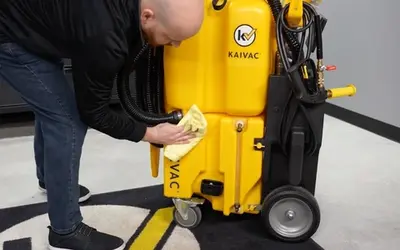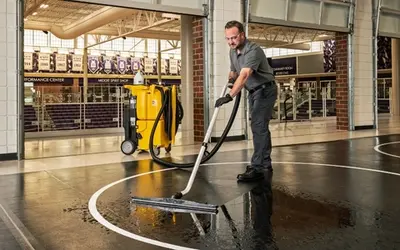Cleaning Public Toilets: COVID-19 Edition

Cleaning public toilets remains one of the most important jobs for maintenance workers. There’s plenty of research about the benefits, both real and perceived, of a clean, fresh-smelling public bathroom. Past studies show that unpleasant restroom experiences creates negative perceptions and a potential loss of customers and sales. And bathroom dangers, like contracting streptococcus, staphylococcus, E. coli and hepatitis A, present real public health risks.
Now add the threat of contracting COVID-19 to the mix and cleaning public toilets has never been more important to human health and economic stability.
Here’s what to consider when looking at your restroom cleaning schedule in the age of Coronavirus.
COVID-19 and Public Restrooms: What are the Risks?
Research and findings change constantly but, according to the CDC, the virus spreads mainly by person-to-person contact. The CDC also says it may be possible to get COVID-19 by touching a surface or object that has the virus on it and then touching their own mouth, nose or eyes. Additionally, mounting evidence suggests that the virus may spread by aerosols, tiny droplets that waft through the air and accumulate over time.
So how risky is it to use a public toilet? Microbiologist Ali Nouri, president of the Federation of American Scientists, summed it up in a CNN article, “They’re not great,” he says. “If you don’t have to use a public restroom, don’t.”
But in the same breath Nouri realizes that this is not really practical advice. “Sometimes when you gotta go, you gotta go,’ he says before breaking down the risks.
Risks of Public Restrooms
- Small spaces: This makes it hard to practice social distancing.
- Poorly ventilated: This means the virus could linger in the air.
- Many touch points: Handles, taps and flushers present hazards.
- Toilet plumes: Tiny microbes can become airborne after each flush and COVID-19 has been found in fecal matter. It remains unclear if these particles are infectious, but still…. eww!
COVID-19 and the Public Restroom: Are Any Even Open?
Because of the uncertainty around infection and the public restroom, some organizations choose to opt-out and close their facilities outright, much to the dismay of road-trippers and parents with small kids. Many fast food outlets moved to a drive-through only model and shuttered their restrooms. Gas stations, another dependable place for a road trip rest stop, have also started closing their restrooms.
And monitor your liquid intake carefully if you’re looking to go thrift shopping. Goodwill Industries of Northwest North Carolina writes that they are “reducing store hours to allow more time for cleaning,” which includes wiping down all high-touch surfaces regularly throughout the day. But the strategy doesn’t include the restroom. “As another precaution bathrooms, break rooms, and water fountains are temporarily closed to the public,” according to their website.
Cleaning Public Toilets: COVID-19 Edition
No matter what phase of reopening an area is in, public restrooms, especially those in essential businesses like grocery stores, will require attention…and lots of it. McDonald’s famously pledged to clean bathrooms every 30 minutes in their “Dine-In Reopening Playbook” distributed to franchisees.
That 30-minute timeline may not be appropriate for every business. Managers must take other factors into account like frequency of use, soil loads and disinfection protocols. But no matter the circumstance, expect to clean more often and more thoroughly than before. That means dedicating staff time to the task and providing the training and tools to get the job done safely and correctly.
That extra time will be important. Industry standards say it takes about three minutes to clean any given restroom fixture be it toilet, urinal or sink. But that doesn’t include hitting all of the important touch points, or the floor which should be considered a touch point as well. And disinfection requires a product be allowed to dwell to work adding extra time to the task.
Cleaning Equipment Upgrades
Consider upgrading your cleaning equipment to make this task easier, safer and faster. Mops, buckets, and rags are slow, cumbersome, and require cleaning staff to get down on their hands and knees to touch every surface. Even worse, they don’t fully remove dirt, bio-pollutants and other soils.
Try a Kaivac No-Touch Cleaning system instead. This innovative spray-and-vac system removes soils from fixtures, floors and walls in one step, leaving surfaces dry and ready to use. Cleaning takes as little as one minute per fixture and workers never have to touch a dirty surface.
For irregular touch points like soap dispensers, light switches, and door handles, try the Smart Towel. With eight numbered quadrants, staff can always use a fresh section, eliminating the possibility of cross contamination.
No doubt, battling COVID-19 requires an enhanced restroom cleaning schedule, but it doesn’t have to stress your staff. Discover more ways Kaivac can help with your public restroom cleaning challenges.
Related Posts

Preventive Maintenance for Your No-Touch Cleaning® System
Your Kaivac No-Touch Cleaning system makes restroom maintenance fast and easy. Keeping your No-Touch Cleaning system in good working order is also fast and easy. Kaivac makes performing preventative maintenance and troubleshooting potential issues simple. No special equipment or technical expertise required.
Read more
A Cleaning Lesson from Schools and Universities that Rely on Kaivac Systems
School, college, and university facilities departments from around the country love their Kaivac Cleaning Systems. Why wouldn’t they? Designed with the custodial worker in mind, these tools and processes from Kaivac are easy to master, work super-fast, and deliver exceptionally clean, fresh-smelling spaces.
Read more
Reduce Absenteeism Through Better School Cleaning
K-12 school leaders are coming up with a variety of ways to combat chronic absenteeism. Strategies like offering in-school laundry services and basic health care show a lot of promise. But providing better cleaning may be one of the most effective, most cost-efficient tactics available.
Read more